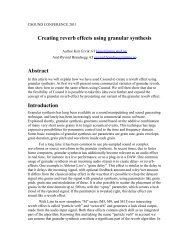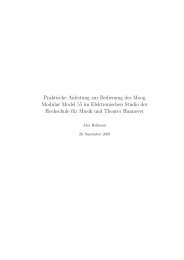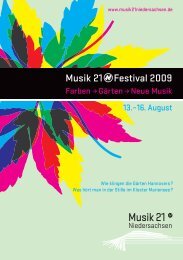Musik im Raum - ZKM
Musik im Raum - ZKM
Musik im Raum - ZKM
Erfolgreiche ePaper selbst erstellen
Machen Sie aus Ihren PDF Publikationen ein blätterbares Flipbook mit unserer einzigartigen Google optimierten e-Paper Software.
3 Software<br />
The system is controlled by the open source software sWONDER, which has been redesigned for<br />
this purpose. 3 The software can be controlled via OpenSoundControl (OSC) 4 , and there have been<br />
several tools created to use the system, ranging from LADSPA 5 and VST 6 plugins to a 3D graphical<br />
interface.<br />
3.1 Control unit<br />
sWONDER is a “distributed application” that communicates over OSC as shown in figure 5. cwonder<br />
is the glue part that each of the other parts communicates with. The only thing the other parts<br />
need to know is the address of cwonder which can be retrieved from a configuration file. The other<br />
parts, or other applications, can connect to different streams that cwonder sends out:<br />
–<br />
–<br />
–<br />
–<br />
/WONDER/stream/render contains all information to render the audio for the sources.<br />
/WONDER/stream/score contains all information to record and play the source movements.<br />
/WONDER/stream/visual contains all information to display the status of all the sources and<br />
settings.<br />
/WONDER/stream/t<strong>im</strong>er gives a regular update on the current t<strong>im</strong>e of the system.<br />
When connected to a stream, cwonder sends out regular messages (“ping”) to which needs to be<br />
replied (with “pong”). If a program that is connected does not reply for a certain amount of t<strong>im</strong>e,<br />
cwonder will stop sending data to that program.<br />
Marije Baalman „How to Control 840 Channels“<br />
fig. 5: Schematic overview of the different parts of the sWONDER software. The control unit can communicate with an<br />
arbitrary number of realt<strong>im</strong>e renderers, offline renderers and user interfaces.<br />
3.2 Audio rendering<br />
The real-t<strong>im</strong>e render unit is responsible for the actual audio signal processing. It has several ways to<br />
deal with the audio streams: playback of direct sound, utilising weighted delay lines, convolution of the<br />
input sound for early reflections, and convolution of the input sound for reverb followed by a weighted<br />
delay lines to create plane waves with the reverb tail. Schematically this is shown in figure 6.<br />
The rendering engine consists of two parts: twonder for the delay line <strong>im</strong>plementation, and<br />
fwonder for the convolution. Both programs are controlled by OSC; audio input and output has the<br />
audioserver JACK (1http://jackaudio.org) as the audio backend. twonder can deal with the different<br />
type sources: a point source (both behind and in front of the loudspeakers) and plane waves (see<br />
fig. 7).<br />
54










